Article Contents:
• How to Warm Up for Spring Activities
• Spring Strength Workout
• 3 Practices to Cultivate Creativity and Find Flow in Your Workout
Ah, spring! It’s the season of reawakening, renewal, and optimism. Like flowers in the garden and birds in the trees, we too are rejuvenated by warmer temperatures and longer days.
“Many people come out of hibernation in spring,” says Katy Bowman, MS, founder of Nutritious Movement and author of Rethink Your Position: Reshape Your Exercise, Yoga, and Everyday Movement, One Part at a Time. With the change in season, the desire to get up, get out, and get moving transcends tradition and habit. Working out might be a year-round activity, but in spring it’s special.
Intriguing research suggests that our bodies are built to behave differently depending on the season. A 2015 study in Nature Communications involving more than 16,000 participants worldwide found that thousands of our genes alter their expression during the year.
During winter in the northern hemisphere, certain genes increase inflammation when you’re most susceptible to infection; this seasonal expression peaks in January and reaches a low point in July. In summer, some genes boost receptivity to sunlight-borne vitamin D.
Come spring, it’s not just the sunshine nudging you to get outside and move. It’s your DNA.
This is why periodization — changing your workout program at regular intervals — spurs improvements in fitness so much more effectively than sticking with the same program for months or years at a time. Trainers and elite athletes know this: They cycle through different training phases to optimize performance during the competitive season. (Learn more about periodized training at “What Is Periodization Training?“)
Exercisers and gym-goers seeking general fitness, longevity, and vitality can benefit from treating spring the way athletes do the preseason. It’s the ideal time to set your long-term fitness goals and jump-start your workout programs.
“You’re catching the wave of what your body wants to do anyway,” says personal trainer Jolie Kobrinsky, CPT, who specializes in unconventional training, blending strength, yoga, steel-club, and steel-mace modalities in her programming.
Even if you’ve stayed active through the winter, spring offers new and different challenges and opportunities for movement, play, and outdoor exploration that can make your body strong, resilient, and athletic.
What follows are a few of the best ways to take advantage of the season.
Preparing Your Body for Outdoor Activities
With spring comes the opportunity to “interact with the earth more,” says Bowman. Compared with the artificial light and controlled temperatures of winter indoors, springtime means more exposure to ever-changing natural sunlight and weather. For some people, resuming outdoor activities can feel like a relief — a literal breath of fresh air. But the transition can bring challenges.
Many popular springtime activities are asymmetrical endeavors. Hiking, trail running, and mountain biking require unilateral and crossbody movements to traverse uneven terrain. Racket sports, like tennis and pickleball, are strenuous full-body workouts that challenge range of motion and stability unequally between the body’s right and left sides. Even walking outdoors brings a challenge if you’ve grown accustomed to walking on a treadmill — or not walking at all.
Springtime home-improvement projects can tax your muscles, joints, and cardiovascular system in ways that won’t feel like exercise — until you’re sore the next day. Gardening and yard work involve bending, squatting, twisting, and reaching (try these seven moves designed to prevent injuries when tackling gardening and yard projects). Cleaning out a basement may require carrying heavy objects up sets of stairs dozens of times. Painting your house may call for reaching overhead while balancing on a ladder, for hours at a time.
“Projects like these require you to lift, turn, and bend in ways we don’t often see in an indoor-training environment,” explains Bowman.
The solution? As spring approaches, spend more time on full-body mobility exercises — with an emphasis on your feet, ankles, and hips — as well as on some rotational and side-bending moves. Seek controlled chaos in your gym sessions, using stability balls, single-leg balances, sandbags, water-filled implements, and TRX exercises in lieu of conventional barbells, dumbbells, and machine exercises.
These varied movements will prepare you for the unpredictability of the most dynamic season of the year.
How to Warm Up for Spring Activities
You can prep for the unpredictable demands of spring with these five moves. Perform the series daily, either on its own or as a warm-up before your favorite activity.
Top-of-Foot Stretch
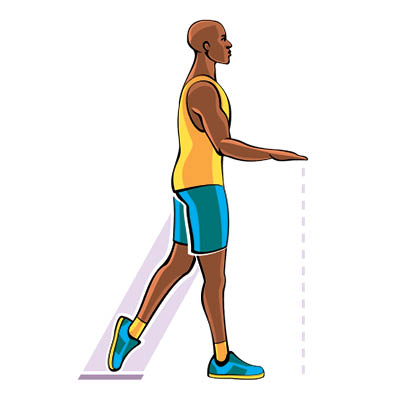
Perform a total of three holds on each side, holding each for up to a minute.
Full Instructions
- Stand tall, holding onto something stationary for balance, if necessary.
- Shift your weight to your right foot and step your left foot behind you.
- Tuck the toes of your left foot under and place the top of your toes on the floor.
- Hold for up to a minute (stop if you start to cramp, then restart when the cramp subsides).
- Switch legs, and repeat. Perform a total of three holds on each side.
Calf Stretch
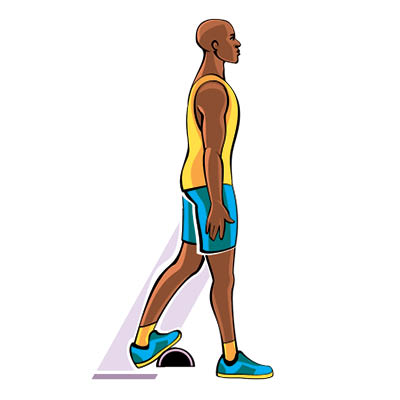
Perform a total of three holds on each side, holding each for one minute.
Full Instructions
- Place the ball of your left foot on the rounded side of a half-round foam roller (with the flat side down) or a rolled-up folded towel and stand tall.
- Drop your left heel all the way to the ground and straighten that knee as much as possible.
- Keeping your weight stacked vertically over the heel of the stretching leg, step forward with your right foot as far as you can without leaning your torso forward.
- Hold for one minute.
- Switch legs and repeat. Perform a total of three holds on each side.
Rotational Lunge
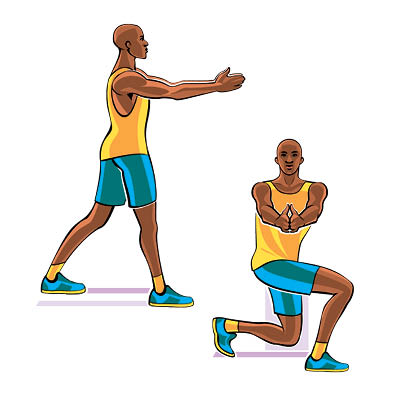
Alternate sides until you’ve completed 12 reps per side.
Full Instructions
- Stand tall with your arms extended directly out in front of you, palms pressed together.
- Step back two to three feet with your left foot.
- Remaining upright, lower yourself until your left knee comes close to the floor behind you.
- Holding the low position, rotate your upper body to the right, keeping your arms straight and your palms pressed together.
- Return to the forward-facing position, then stand fully and return to the starting position.
- Repeat the move, stepping back with your right foot and rotating to the left.
- Continue the move, alternating sides, until you’ve completed 12 reps per side.
Too hard? Reduce the range of motion, lowering yourself only halfway into the lunge position.
Too easy? Perform the same move holding a dumbbell or medicine ball in front of your chest.
Side Plank With March
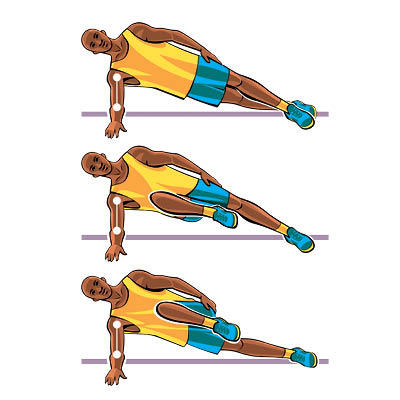
Complete eight reps per side.
Full Instructions
- Lie on your side and prop yourself up on that side’s forearm, stacking your shoulder over your elbow. Press through that arm to keep your shoulder away from your ear and to maintain a long neck.
- Extend your legs, staggering your feet so they are both on the floor. Position the foot of the top leg in front of the foot of the bottom leg.
- Press through your base arm and feet and raise your body off the floor. Engage through your core and the muscles of your base arm and legs, keeping your hips elevated.
- Draw one knee up toward your chest, balancing on your forearm and the opposite foot.
- Replace the raised foot on the floor and draw the opposite knee toward your chest.
- Continue marching in this manner, alternating sides, to complete eight reps per side.
- Rest as needed, then repeat on the opposite side.
Too hard? Hold a side plank with both feet planted, or with the top foot planted and the bottom knee on the floor, for up to 30 seconds.
Rotational Overhead Press
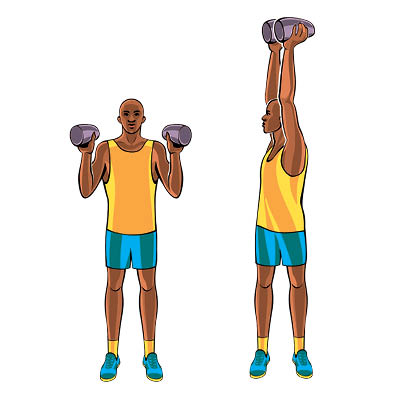
Repeat for a total of three sets on each side.
Full Instructions
- Stand upright, holding a sandbag in both hands at shoulder height. (Alternatively, you could use a ViPR tube, which can be found in most Life Time clubs.)
- Press the bag overhead fully, simultaneously rotating your body as far as comfortably possible to the right.
- Lower the bag back to shoulder height and repeat, rotating as far as you can to the left.
- Continue the move, alternating sides, until you’ve completed eight reps per side.
- Repeat for a total of three sets on each side.
Adopt a Minimalist Strength Routine
With the seasonal emphasis on outdoor activities like hiking, cycling, rucking, and racket sports, you’ll likely have less time for lengthy strength workouts in the gym — and that’s OK, says Marcus Filly, CSCS, a strength-and-conditioning coach and functional-movement specialist.
According to the science of periodized training, adapting — and even scaling back on — your strength-training routine in the spring can help you avoid burnout, overtraining, and overuse injuries.
“Let’s say that in the spring, you ease up on your gym time — but you also start playing Ultimate Frisbee or pickleball twice a week for an hour,” says Filly. With two more hours of intense weekly exercise now on your schedule, it’s not just natural but critical to adapt the rest of your routine.
“A lot of people’s energy expenditure goes up considerably in spring,” he adds, so you’ll likely find that you need additional fuel and active recovery to keep up with the additional movement.
But don’t give up on the gym altogether. Spring is a great time for a low-volume, high-intensity approach to strength training that supports your other activities. The key is to adopt a minimalist strategy of performing fewer sets with meaningful — though not necessarily maximal — effort.
“You don’t always have to work at a maximal level in every aspect of your fitness,” notes Filly. “You’ll probably get fitter and stronger in the long run if you stop trying so hard at everything, all the time.”
How to Go Minimal
Doing just what’s needed in the gym — no more, no less — is a great choice in springtime. “I like the two-by-two approach,” says Filly. “Each workout consists of two hard sets of two major moves” — one upper body, one lower body — “plus a couple of sets each of about four lighter, simpler moves.”
Here is a sample full-body, two-by-two workout that’s fast, efficient, and complementary to other activities outside the gym.
Spring Strength Workout
- For your primary lower- and upper-body moves, choose one lift per category per workout session.
- Complete straight sets of each move before going on to the next exercise.
- Repeat this workout three times per week, mixing up the primary moves as desired.
Exercise |
Sets |
Reps |
| Primary Lower-Body Move: (pick one) – Back Squat – Deadlift – Hip Thrust |
5 sets | Sets 1–3: Begin these warm-up sets with a light set of 12 reps. Then gradually increase the weight to something you can lift no more than eight times. This is your working weight. |
| Sets 4–5: 6 reps |
||
| Primary Upper-Body Move: (pick one) – Bench Press – Overhead Press – Pull-Up |
5 sets | Sets 1–3: Begin these warm-up sets with a light set of 12 reps. Then gradually increase the weight to something you can lift no more than eight times. This is your working weight. |
| Sets 4–5: 6 reps |
||
| TRX Row | 1–2 sets | 15 reps |
| Stability-Ball Leg Curl | 1–2 sets | 15 reps |
| One-Legged Dumbbell Curl | 1–2 sets/side | 15 reps |
| Side Plank | 1–2 sets/side | 15–30 seconds |
Full Spring Strength Exercise Instructions
Back Squat
- Inside a squat rack, position a loaded barbell on your upper traps, just below the bony part of the back of your neck.
- Positioned directly under the bar, stand up with the weight and then, taking small steps, back up until you’ve cleared the hooks.
- Initiate the squat by pushing your butt backward and bending your knees.
- Keeping your torso upright, your spine neutral, and your knees in line with your toes, lower yourself as far as you are comfortably able. (If it’s not far, adjust the position of your feet and try turning your toes slightly outward, but don’t go farther than is comfortable.)
- As you descend, keep your knees tracking in the same direction as your feet, then push off the floor to stand to a full lockout.
- Return to the starting position. Perform three warm-up sets, followed by two working sets of six reps. (Refer to the table for details.) Conventional barbell back squat not right for you? Try other variations, such as a goblet squat or front squat using dumbbells or kettlebells, to find what feels good.
(Go here to see how to do a back squat.)
Deadlift
- Step up to a loaded barbell so it is touching your lower legs at mid-shin. Hinge at the hips first, then allow your knees to bend as you reach down to take a shoulder width grip on the bar.
- Stand fully upright, with your arms straight and head in a neutral position, by pressing your feet into the floor and pushing your hips forward. At the top of the lift, squeeze your glutes to achieve a full lockout. Do not arch your back.
- Hinge at the hips again and bend the knees to lower the bar to the floor. Perform three warm-up sets, followed by two working sets of six reps. (Refer to the table for details.) .
- Conventional barbell deadlifts not right for you? Try other variations (like sumo or trap bar deadlifts) and other implements (like dumbbells or kettlebells) to find what feels good.
(Go here to see how to do a deadlift, plus see variations of this foundational strength move.)
Hip Thrust
- Sit on the floor and position your upper back against a flat bench.
- Roll a loaded barbell up your legs to the crease of your hips and bend your knees so your feet are flat on the floor. (If needed for comfort, place a rolled-up yoga mat between your hips and the bar.)
- Hold the bar in place and press your hips into the air until they are fully extended. Your back should rest on the bench.
- Lower your hips and the barbell back down, keeping your upper back pressed against the bench throughout the movement. Perform three warm-up sets, followed by two working sets of six reps. (Refer to the table for details.)
(Click here for an illustration of a hip thrust.)
Bench Press
- Lie on a bench with a barbell on a rack in line with the top of your head. Keeping your feet flat on the floor, take an overhand grip on the bar, lift it off the uprights, and slowly align it with your mid-chest while keeping arms extended. Inhale and brace your core, then slowly lower the bar until it contacts the lower part of your chest. Aim elbows out about 45 degrees from your body.
- Squeeze your glutes and push your feet into the floor as you press the bar back to the starting position. Pause at the top, arms fully extended, and exhale. Keep your abs and glutes engaged as you release your breath. Perform three warm-up sets, followed by two working sets of six reps. (Refer to the table for details.) .
- Return the bar to the rack with control.
- No barbell? Perform this move with a pair of dumbbells or kettlebells.
(See “How to Do the Bench Press” for more on this move, plus variations.)
Overhead Press
- Place a barbell in a rack at shoulder height. Load it with an appropriate weight (or, if you’d like, use just the bar with no added weight) and stand facing it.
- Assume an overhand grip and step close to the bar, allowing it to sit across your chest on the front of your shoulders. With feet about hip width apart, lift the bar up and step away from the rack.
- With control, press the barbell straight overhead, moving your chin out of the way. Once your arms are straight overhead, reverse the movement and slowly lower the bar back to your chest.
- Perform three warm-up sets, followed by two working sets of six reps. (Refer to the table for details.).
- No barbell? Perform this move with a pair of dumbbells or kettlebells.
(For more on the overhead and variations, see “How to Mix Up the Overhead Press.”)
Pull-Up
- Jump up or use a box to step up to grasp a pull-up bar with a double-overhand grip.
- Assume an active-hang position by engaging your scapulae, lengthening your neck, engaging your core, and squeezing your glutes.
- Use your lats to pull your elbows down to your sides. Keep your neck neutral and avoid reaching up with your chin.
- Stay engaged as you pull your body upward until your chin clears the bar.
- Reverse the motion with full control and return to an active-hang position. Perform three warm-up sets, followed by two working sets of six reps. (Refer to the table for details.) .
- Too hard? Perform foot-supported pull-ups: Set a bar in a rack at about torso height while standing. Grasp the bar and lower yourself to the floor so that your arms are straight and your feet are slightly in front of you. With your hips below your hands, pull yourself up until your chin is over the bar, using assistance from your feet as needed.
(Here’s a 30-day program to help you get to your first pull-up.)
TRX Row
- Standing a few feet behind the anchor point for a TRX (or equivalent suspension training system), raise the handles to chest height and walk backward until the straps are taut.
- Keeping your arms extended, walk your feet forward until your body forms about a 45-degree angle to the floor.
- Keeping your body straight, head to heels, and your head in a neutral position relative to your spine, simultaneously bend your arms and pull your shoulder blades back, lifting your chest as high as you can toward the anchor point.
- Pause, slowly reverse the movement, and repeat for one to two sets of 15 reps.
- To make the move easier, start with your feet farther back.
- To make the move more difficult, start with your feet farther forward.
(Click here to see a short demo of the TRX row.)
Stability-Ball Leg Curl
- Lie on your back with your heels elevated on a medium-size stability ball, feet about 6 inches apart.
- Extend your hips so that only your upper back, head, and arms are on the floor. This is your starting position.
- Keeping your body straight from your knees to your neck, bend your knees, lifting your hips as high as possible, and squeezing your hamstrings at the top of the movement.
- Slowly straighten your legs, returning to the starting position. Repeat for one to two sets of 15 reps.
One-Legged Dumbbell Curl
- Stand upright, holding a pair of dumbbells by your sides, palms facing forward.
- Shift your weight to your left leg and raise your right foot.
- Maintaining your balance on one leg, slowly curl the dumbbells to shoulder height.
- Reverse the motion by slowly lowering the dumbbells back to the starting position.
- Complete 15 reps, keeping your right foot raised for the duration of the set.
- Rest for one minute, then repeat with the opposite leg raised. Perform one to two sets.
- Balance an issue? Instead of fully raising one leg, lightly place your toes on the floor as a kickstand for added support.
Side Plank
- Lie on your side and prop yourself up on that side’s forearm, stacking your shoulder over your elbow. Press through that arm to keep your shoulder away from your ear and maintain a long neck.
- Extend your legs. Stack your upper foot on top of the bottom one, if it’s comfortable, or stagger your feet so they are both on the floor.
- Press through your base arm and feet and raise your body off the floor. Engage through your core and the muscles of your base arm and legs, keeping your hips elevated.
- Hold for 15 to 30 seconds.
- Rest for one minute, then repeat on the opposite side. Perform one to two sets.
- Too hard? Drop the knee of the bottom leg for added support.
- Too easy? Reach your top arm under and across your body as far as possible, then return to the starting position, and repeat for 12 reps on each side. For an additional challenge, raise your top leg as high as possible toward the sky as you return your arm to the vertical position.
(Take your side plank to the next level with two challenging variations.)
Embrace the Power of Flow
When most people think about getting fit, their brains jump to structure and schedules. Some structure is, of course, necessary. But too much can be limiting, especially in a season known for spontaneity and freedom.
“Spring is all about letting go and being creative,” says Kobrinsky. It’s an opportunity to dedicate at least some of your workout to activities that allow for playfulness and improvisation — qualities that form the foundation of the elusive state called flow.
Also known as “getting in the zone,” flow is “the state where your inner critic turns off,” she explains. “You become absorbed in the task at hand.”
Flow is the opposite of multitasking. Absorbed in an activity like running or cycling on a beautiful trail, you’re less inclined to pause, consider, qualify. Body, mind, impulse, and action are unified. You’re switched on.
Begin to cultivate flow with tools or movements that use little to no resistance, Kobrinsky says. “The lower the resistance, the freer you can be with it. The opposite is also true: The higher the resistance, the smaller your room for error, so the less creative — but the more practiced — you should be.”
Powerlifters, who hoist weighty one-rep maxes, are sticklers for form with little to no deviation. But boxers, dancers, and others who work mostly with their own body weight leap, fold, slip, weave, turn, and bend with abandon.
While flow is more accessible during absorbing, low-resistance activities like dancing and martial arts, you can find your way to it with more conventional movements too.
Let’s say you’re doing dumbbell flies. Kobrinsky suggests that you remain open and curious about what you’re feeling. “You might sense that with your arms outstretched, your heart feels open. That you feel expansive, open, powerful.”
Then, as you draw the dumbbells upward, you might feel like you’re embracing the world, hugging it to you. If these images don’t resonate, she encourages you to find your own: “You’re trying to stay fully present in what you are doing.”
Another key to flow is your breathing. “Marrying breath to movement is one of the most effective ways to create the flow state,” Kobrinsky says.
Yoga practitioners know that exhaling is associated with the yin energy of relaxation, surrender, and release; inhaling is associated with the yang energy of action, dynamism, and power. Experiment with emphasizing and elongating one or the other, depending on the activity.
Cultivating and practicing flow can free you from old patterns and lay groundwork for new ones, Kobrinsky notes. “Flow state reinforces the idea that you have autonomy. You don’t have to be oppressed by your schedule or your datebook, chasing your own tail.”
In effect, she adds, you’re manifesting a different internal state: “You drop into a different reality, one that supports expansiveness and cohesiveness in the body.”
3 Practices to Cultivate Creativity and Find Flow in Your Workout
Flow isn’t something you actively perform, but to set yourself up for it, you must train your mind. It happens only under the right circumstances, and to find it requires discipline and attention to detail. To set the groundwork, and to make sure you catch the flow wave when it comes on, try these practices recommended by Kobrinsky.
Take Up
Journaling
It’s not a physical practice, but journaling helps you cultivate a familiarity with your inner landscape: your thoughts, feelings, aspirations. This inner work resembles the growth of root systems in spring, supporting and enhancing growth in our bodies.
“You’ll understand more clearly what made you upset or happy or disappointed or ecstatic today instead of getting buffeted by those emotions like a ship in a storm,” Kobrinsky says.
Not sure what to write? Start by listing three things you’re grateful for and three things you consider areas for further exploration and growth. (Explore six types of journaling at “How to Use Journaling for Mental Health.”)
Play With
Your Breath
“When you’re strength training, experiment with breathing out during exertion and in as you lower the weight,” she suggests. “Then deliberately switch it around,” breathing in as you lift and out as you lower.
Try something similar as you run. If you normally inhale for three steps and exhale for two, try doing the opposite.
Both approaches can be instructive and powerful and bring a meditative quality to your training, even when you’re working at close to your full capacity. (To learn more about the art of breathing, visit “How to Breathe.”)
Find Your Fitness Rhythm
“Working at or close to your edge every time you exercise can only take you so far,” Kobrinsky warns. To avoid burnout, balance your efforts by adopting a “low-medium-high-no” rhythm to your activity.
“Every four days, include one easy workout, one medium-hard workout, one high-intensity workout, and one rest day,” she explains. What qualifies as easy/low-intensity versus hard/high-intensity will vary from person to person, so heed your body’s signals to balance all-out efforts with adequate recovery. (Discover why workout recovery is essential for optimal fitness at “Why Workout Recovery Days Are Essential for Optimal Fitness.“)
This article originally appeared as “Spring Training” in the March/April 2024 issue of Experience Life.








This Post Has 0 Comments